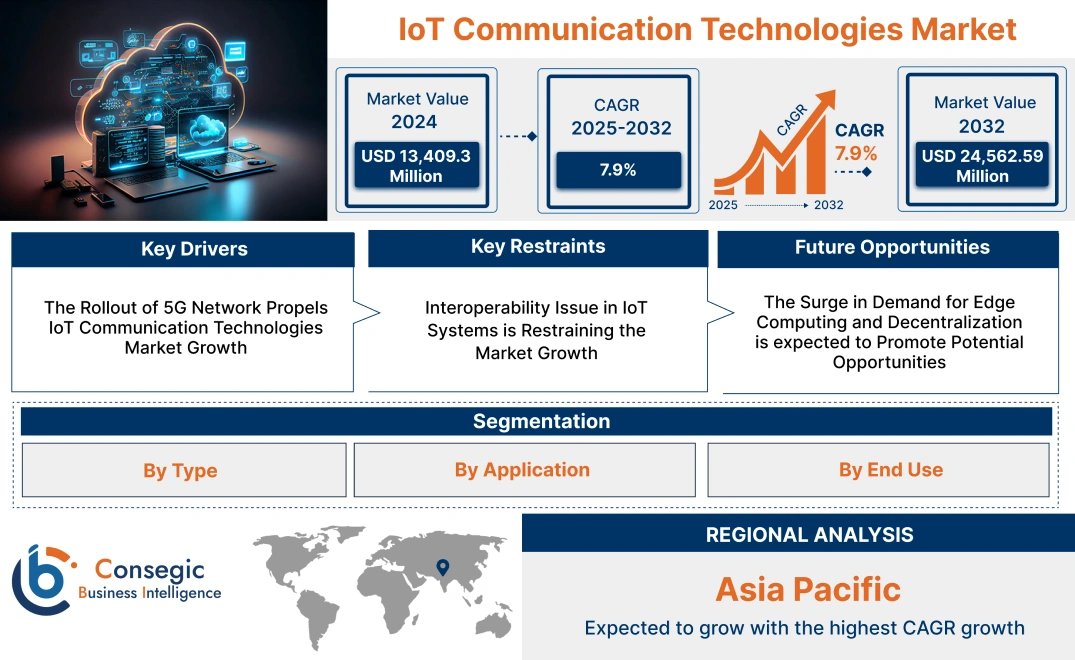- Summary
- Table Of Content
- Methodology
IoT Communication Technologies Market Size:
IoT Communication Technologies Market size is estimated to reach over USD 24,562.59 Million by 2032 from a value of USD 13,409.30 Million in 2024 and is projected to grow by USD 14,224.34 Million in 2025, growing at a CAGR of 7.9% from 2025 to 2032.
IoT Communication Technologies Market Scope & Overview:
The IoT communication technologies refer to standard protocols and services used to integrate IoT devices with networks allowing them to communicate with each other. Additionally, the advantages include enhanced operational efficiency, improved decision-making, cost savings, and resource optimization among others. Additionally, the types include Wi-Fi, Bluetooth, ZigBee, Z-wave, Lora, NFC, RFID, and others. The IoT communication technologies market is majorly driven by the surge in demand for IoT-embedded electronic devices, propelling the market development. The technologies find application in major end-user industries including aerospace & defense, automotive, information and communication technology, power and energy, healthcare, and others.
IoT Communication Technologies Market Dynamics - (DRO) :
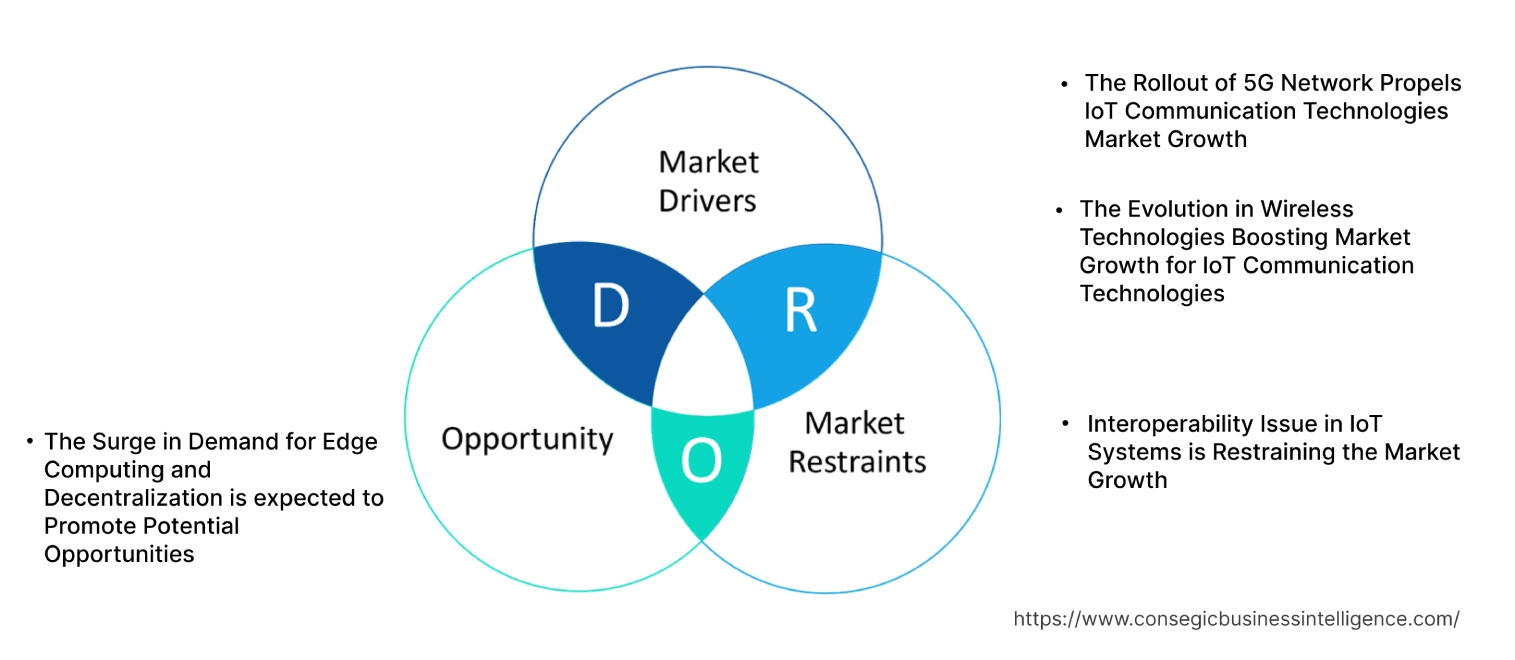
Key Drivers:
The Rollout of 5G Network Propels IoT Communication Technologies Market Growth
The rise of the 5G network is having a significant impact on IoT technologies by enhancing mobile broadband, ultra-low latency communications, improved speed, and energy-saving functions for both indoor as well as outdoor devices. The 5G network provides a seamless integration of various IoT devices with negligible lag in control and monitoring facilities.
- In November 2023, the government of Luxembourg announced a 5G communication technologies project that offers companies and research institutions a new funding opportunity. The project aims to take advantage of 5G communication technologies in the field of research or business.
Thus, the rise of the internet with the rollout of the 5G network is driving the IoT communication technologies market.
The Evolution in Wireless Technologies Boosting Market Growth for IoT Communication Technologies
Wireless technology refers to the wireless communication between two or more devices. The wireless technologies are the most desired mode of communication or connectivity. The technology uses electromagnetic waves, such as radio frequencies, infrared, and satellite to deliver communication. Additionally, applications range from (3G/4G/5G) cellular devices, broadband access, Wi-Fi networks, vehicle-to-vehicle (V2V) systems, embedded sensors, and radio frequency identification (RFID).
- In June 2023, Ellisys announced the integrated Wi-Fi 6E capabilities on Bluetooth Vanguard which enhances the wireless protocol analysis system. The capability allows Bluetooth to analyze Wi-Fi 6E traffic by synchronizing with Bluetooth and LR-WPAN technologies including ZigBee, raw RF spectrum, and other wired communications protocols.
Therefore, the evolution of wireless technologies is driving the market trend.
Key Restraints :
Interoperability Issue in IoT Systems is Restraining the Market Growth
The IoT systems are rapidly growing and so is the need for them to work together seamlessly. The lack of interoperability significantly impacts their adaptability. Without interoperability, various IoT devices work on different frequencies and use protocols such as Zigbee, Bluetooth, and Wi-Fi as per the requirement. The lack of interoperability leads to operational inefficiencies and increased costs which hampers the market progress.
Therefore, the interoperability hampering operational inefficiencies and increased costs is restraining the IoT communication technologies market development.
Future Opportunities :
The Surge in Demand for Edge Computing and Decentralization is expected to Promote Potential Opportunities
Edge computing enables a transformative approach to processing data and reduces the dependency on central servers which minimizes latency and bandwidth issues and improves processing speed. Additionally, decentralization improves the real-time data processing across various devices as well as enhances the system's responsiveness. Edge computing and decentralization are beneficial in industries such as manufacturing and automotive among others driving the IoT communication technologies market expansion.
- In May 2024, Tata Communications launched CloudLyte , which is a fully automated edge computing platform catering to emerging technologies such as 5G and IoT. The platform enables real-time data processing, low latency applications, and intelligent decision-making which helps enterprises to thrive in a data-driven world.
Hence, the rising demand for processing data and reducing the dependency on central servers is anticipated to drive the global IoT communication technologies market opportunity.
IoT Communication Technologies Market Segmental Analysis :
By Type:
Based on the type, the market is segmented into Wi-Fi, Bluetooth, ZigBee, Z-wave, Lora, NFC, and others.
Trends in the Type:
- IoT wearable devices are leveraging Bluetooth technology for seamless data communications and data sharing between other smart devices such as smartphones.
- Zigbee 3.0 uses cryptographic algorithms for encryption which provide authentication and confidentiality and make network-wide encryption mandatory.
Wi-Fi accounted for the largest revenue share in the year 2024 and is anticipated to register the fastest CAGR during the forecast period.
- The rising adoption of Wi-Fi is due to low cost and transmission characteristics. Wi-Fi is a technology that allows electronic devices to connect wirelessly through local area networks.
- Wi-Fi is the best-known type which operates at high frequency with a middling range. Local and personal area networks use Wi-Fi communications with 2.4G UHF and radio frequency bands 5G SHF ISM is driving the progress of the segment.
- In October 2022, Fibocom launched FG370 which is a 5G module. The benefits of the module include low latency, enhanced mobile broadband, and ultra-reliable 5G fixed wireless access connectivity solution for global operators and is powered by the MediaTek T830 platform.
- Thus, the Wi-Fi segment is driving the IoT communication technologies market share.
By Application:
Based on the application, the market is segmented into building automation, traffic lights, health monitoring devices, smart washing machines, smart meters, and others.
Trends in the Application:
- The building automation is heavily relying on advanced sensors and the Internet of Things (IoT) for effective building management and seamless integration with various sensors and controllers.
- The integration of IoT technologies for communication with health monitoring devices is reducing latency and making real-time data analysis possible as well as enhancing precision, efficiency, and outcomes in medical procedures.
The traffic light accounted for the largest revenue share of 26.93% in the year 2024.
- IoT communication technologies enable traffic infrastructure operators to monitor and manage critical traffic control devices, such as traffic signals and warning systems.
- Moreover, the key factor propelling the development of the segment is the capability of the market to exchange data in real-time and utilize vast amounts of data from various sources, such as vehicles, traffic signals, surveillance cameras, and road sensors.
- In June 2023, Applied Information partnered with Alpha Technologies Inc. to integrate Internet of Things (IoT) connectivity with battery backup systems. The new capability enhances the reliability and uptime of the traffic control infrastructure.
- Thus, as per the analysis, the traffic light segment is driving the IoT communication technologies market trends.
The smart meter is anticipated to register the fastest CAGR during the forecast period.
- Smart meters enable proactive management of power consumption and facilitate efficient monitoring of electricity usage. The smart meter features include instantaneous data collection, improved grid dependability, and customer satisfaction.
- Further, the primary factor driving the smart meter segment is due to the advancement of communication technologies for smart meters and significant transformation in electricity grids.
- In September 2024, Yorkshire Water announced the exchange of 1.3 million water meters for smart meters across the Yorkshire region. The Netmore group is set to provide end-to-end service, including the delivery, installation, commissioning, and maintenance of connected smart meters.
- Therefore, the smart meter is anticipated to boost the evolution of the market during the forecast period.
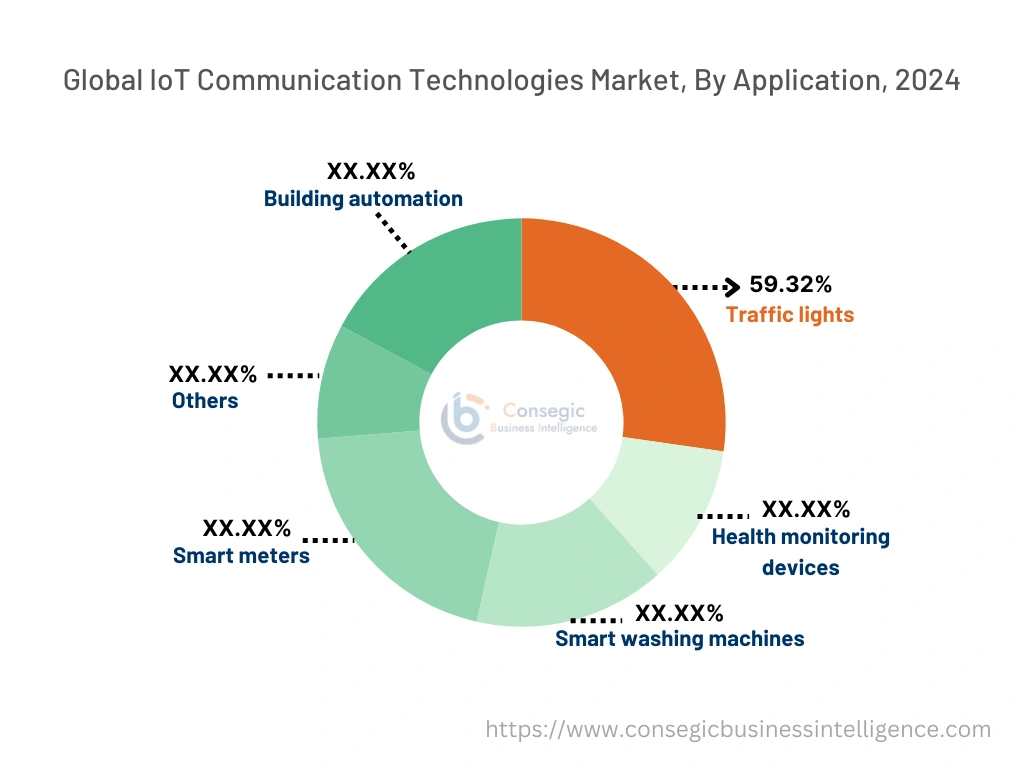
By End-User:
Based on the end use, the market is segmented into aerospace & defense, automotive, information and communication technology, power and energy, healthcare, and others.
Trends in the End-User:
- Expansion of the Healthcare industry is leveraging IoT communication technologies to integrate various tasks ranging from patient monitoring to inventory management for improving patient care and resource management.
- The integration of IoT communication technologies within aerospace enhances operational efficiency and safety as well as helps in data-driven decision-making in real time.
Information and communication technology accounted for the largest revenue share in the year 2024.
- Information and Communication Technologies refers to all communication technologies, including the internet, wireless networks, cell phones, computers, software, and others.
- The ICT sector empowers IoT organizations by providing network connectivity, data analytics capabilities, and cloud computing platforms which are necessary for IoT devices to connect, communicate, and share data.
- In July 2023, Bharti Airtel's B2B division announced its achievement of connecting over 20 million devices through its IoT solutions. IoT enables enterprises across various industries to safely transmit customer data across connected devices including automobiles, energy, utilities, and more.
- Thus, according to the market analysis ICT sector is driving the IoT communication technologies market trends.
The automotive industry is anticipated to register the fastest CAGR during the forecast period.
- IoT communication technologies when embedded in automotive vehicles provide an added advantage by enhancing vehicle-to-vehicle communication ensuring safety and avoiding accidents.
- Moreover, the increased demand for immersive in-vehicle experiences and next-generation interactive entertainment technologies in vehicles is boosting the progress of the segment.
- In February 2024, Qualcomm Technologies, Inc. unveiled Qualcomm QCA6797AQ, which is an automotive-grade Wi-Fi 7 solution for vehicles. The Wi-Fi 7 features new technologies including high band simultaneous, multi-link multi-radio, and 320 MHz channel bandwidth among others.
- Therefore, the automotive sector is anticipated to boost the development of the market during the forecast period.
Regional Analysis:
The regions covered are North America, Europe, Asia Pacific, the Middle East and Africa, and Latin America.
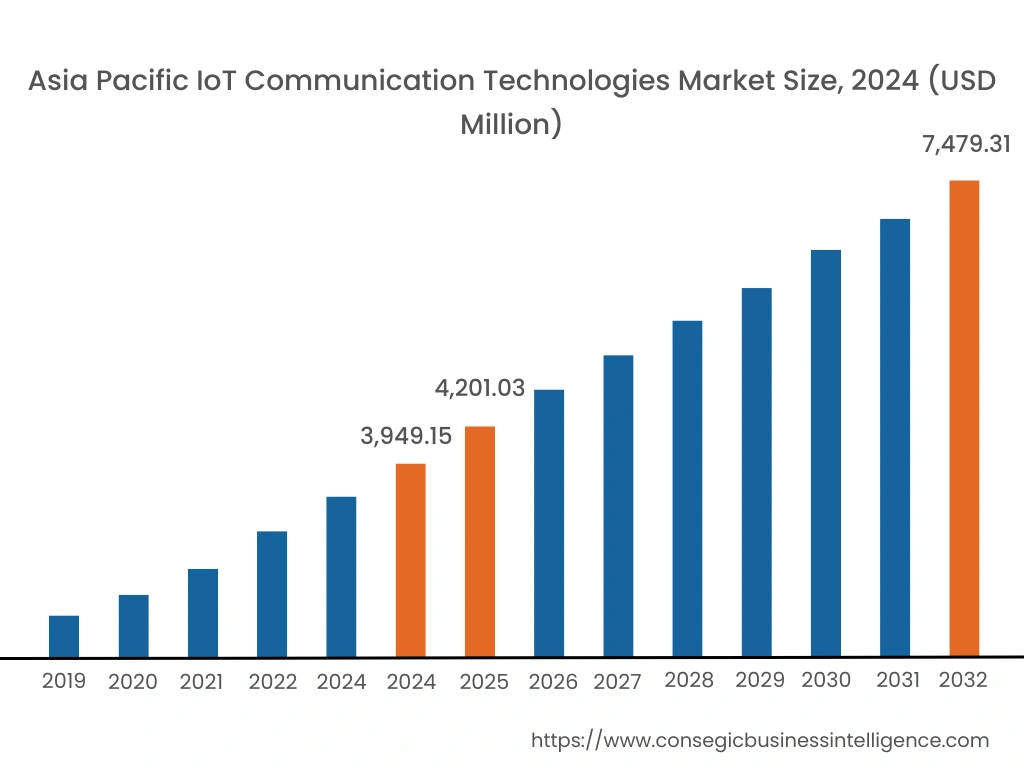
Asia Pacific Region was valued at USD 3,949.15 Million in 2024. Moreover, it is projected to grow by USD 4,201.03 Million in 2025 and reach over USD 7,479.31 Million by 2032. Out of this, China accounted for the maximum revenue share of 34.2%. The Asia Pacific region's growing urbanization and increasing adoption of IoT devices offer lucrative progress prospects for the market. Additionally, the development of industrial automation and widespread access to the internet is driving IoT communication technologies market demand.
- In August 2021, Fibocom based out in China, launched FM101 which is LTE Advanced module series. The FM101 features an M.2 form factor and an optimized LTE-A module series designed to boost higher efficient connectivity for applications including CPE, STB, IIoT, and others.
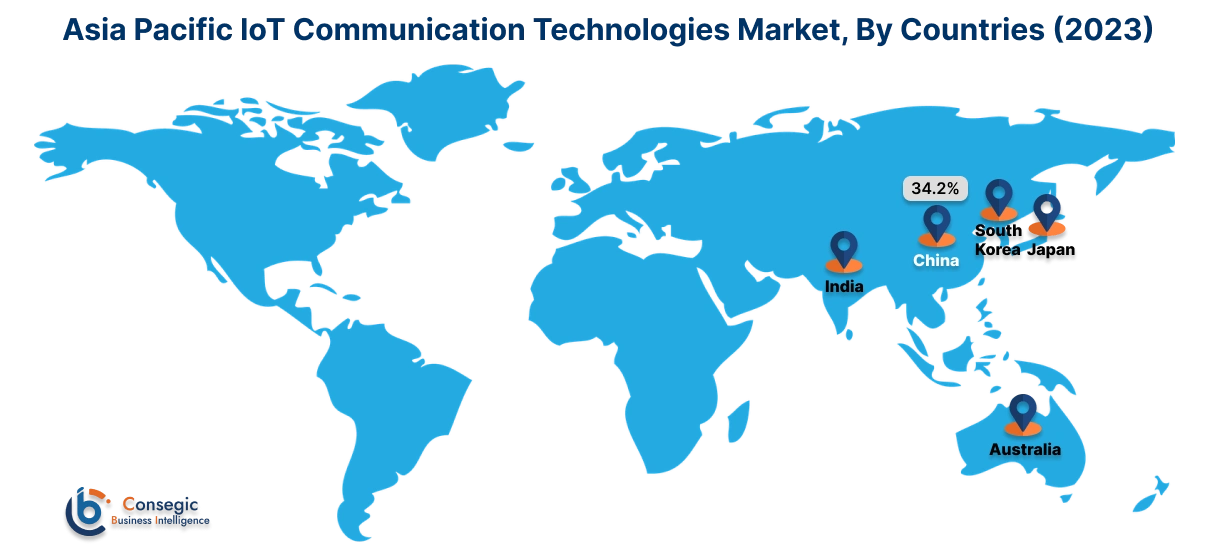
North America is estimated to reach over USD 7,960.74 Million by 2032 from a value of USD 4,447.98 Million in 2024 and is projected to grow by USD 4,709.31 Million in 2025. The market evolution is mainly driven by its deployment in healthcare, automotive, smart cities, and other industries for remote monitoring and control over devices. Factors including rising adoption of next-generation communication standards, digital twins, and enterprise transformation IoT Security are projected to drive the market growth in North America during the forecast period.
- For instance, in November 2023, Phantom Neuro based out in the US, launched medical devices embedded with IoT Wi-Fi technology which is replacing outdated medical standard communications technologies.
Additionally, according to the analysis, Europe is anticipated to witness substantial progress that is backed by the smart cities initiative and industry 4.0 as well as the machine-to-machine (M2M) communication technology catering to the surging market trend across the region.
Further, as per the IoT communication technologies market analysis, the Middle East and African region is experiencing substantial growth in the smart city project which is utilizing IoT networks for monitoring and control infrastructural development and technological advancement is driving the market development in the region.
Furthermore, the Latin American region is expected to grow at a considerable rate owing to the rising adoption of IoT technologies in enhancing traffic management, energy efficiency, and public safety is driving the IoT communication technologies market in the region.
Top Key Players & Market Share Insights:
The IoT communication technologies market is highly competitive with major players providing communication technologies to the national and international markets. Key players are adopting several strategies in research and development (R&D), product innovation, and end-user launches to hold a strong position in the IoT communication technologies market. Key players in the IoT communication technologies industry include-
- Microchip Technology (U.S)
- Fibocom Wireless Inc. (APAC)
- EnOcean (Europe)
- PTC Inc. (U.S)
- MediaTek (APAC)
- Telindus (Europe)
- Telit (UK)
- Link Labs (U.S)
- Gemalto (Europe)
- STMicroelectronics (Europe)
Recent Industry Developments :
Product Launches:
- In November 2023, Shenzhen RF-star Technology Co., Ltd. launched a digital key with Bluetooth, ultra-wideband, and NFC for the automotive sector due to a rising trend towards car connectivity consortium (CCC).
Partnerships & Collaborations:
- In February 2024, Fibocom partnered with Askey, Quanta Computer, and PLANET, companies to launch a 5G RedCap module solution for 5G IoT development. The 5G RedCap enables data transmission and efficient network utilization in various applications including in-home connectivity, enterprise-level connectivity, and industrial-grade connectivity among others.
IoT Communication Technologies Market Report Insights :
| Report Attributes | Report Details |
| Study Timeline | 2019-2032 |
| Market Size in 2032 | USD 24,562.59 Million |
| CAGR (2025-2032) | 7.9% |
| By Type |
|
| By Application |
|
| By End-User |
|
| By Region |
|
| Key Players |
|
| North America | U.S. Canada Mexico |
| Europe | U.K. Germany France Spain Italy Russia Benelux Rest of Europe |
| APAC | China South Korea Japan India Australia ASEAN Rest of Asia-Pacific |
| Middle East and Africa | GCC Turkey South Africa Rest of MEA |
| LATAM | Brazil Argentina Chile Rest of LATAM |
| Report Coverage |
|
Key Questions Answered in the Report
How big is the IoT communication technology market? +
IoT Communication Technologies Market size is estimated to reach over USD 24,562.59 Million by 2032 from a value of USD 13,409.30 Million in 2024 and is projected to grow by USD 14,224.34 Million in 2025, growing at a CAGR of 7.9% from 2025 to 2032.
What specific segmentation details are covered in the IoT communication technology report? +
The IoT communication technology report includes specific segmentation details for type, application, end-user, and region.
Which is the fastest segment anticipated to impact the market growth? +
In the IoT communication technology market, the Wi-Fi segment is the fastest-growing segment during the forecast period due to low cost and transmission characteristics as well as allowing electronic devices to connect to a wireless local area network is driving the market.
Who are the major players in the IoT communication technology market? +
The key participants in the IoT communication technology market are Microchip Technology (U.S), Fibocom Wireless Inc. (APAC), Telindus (Europe), EnOcean (Europe), PTC Inc. (U.S), MediaTek (APAC), Telit (UK), Link Labs (U.S), Gemalto (Europe), STMicroelectronics (Europe) and others.
What are the key trends in the IoT communication technology Market? +
The IoT communication technology market is being shaped by several key trends including the rise of Industry 4.0, ZigBee 3.0, automation, and rising adoption across various sectors including automotive, healthcare, and aerospace are the key trends driving the market trend.
